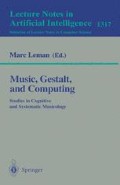Abstract
The following text deals with timbre-dependent stream segregation. Combining the ideas of Gestalt principles, auditory scene analysis and Schumann's principles of timbre, the following hypotheses are proposed and examined: (i) Alternating timbres with matching formant positions are perceived for the most part as one sole melodic stream. (ii) Alternating timbres with non-matching formant positions are perceived for the most part as two interwoven melodic streams. (iii) Alternating timbres which have on the one hand formants and on the other hand fluctuations as primary attributes are perceived for the most part as two interwoven melodic streams. (iv) Alternating timbres of which the main attributes are fluctuations are perceived for the most part as one sole melodic stream. In this experiment based on Wessel (1985), hypotheses 2 and 3 were fully confirmed, whereas hypotheses 1 and 4 could not be fully confirmed. Possible causes for this are discussed: the invariable melodic contour of the stimuli as well as the tempo in which they were played; furthermore, the mental situation of the subjects at the time of the experiment.
Preview
Unable to display preview. Download preview PDF.
References
Auhagen, W. (1987). Dreiecksimpulsfolgen als Modell der Anregungsfunktion von Blasinstrumenten. Fortschritte der Akustik, 13, 709–712.
Bregman, A. (1990). Auditory scene analysis: The perceptual organization of sound. Cambridge, MA: The MIT Press.
Bregman, A., Levitan, R., & Liao, C. (1990). Fusion of auditory components: Effects of the frequency of amplitude modulation. Perception and Psychophysics, 47, 68–73.
Dowling, W., & Harwood, D. (1986). Music cognition. New York, NY: Academic Press.
Fricke, J. (1975). Formantbildende Impulsfolgen bei Blasinstrumenten. In Fortschritte der Akustik, 4. DAGA '75 (pp. 407–411). Braunschweig.
Fricke, J. (1993). Die Wechselwirkung von Mensch und Instrument im Zusammenspiel von Physik und Psychologie. In B. Enders (Ed.), Neue Musiktechnologie, Vortärge und Berichte vom Klangart-Kongress 1991 an der Univ. Osnabrück. Mainz: Schott.
Grey, J. (1977). Multidimensional perceptual scaling of musical timbres. The Journal of the Acoustical Society of America, 61, 1270–1277.
Grey, J., & Gordon, J. (1978). Perceptual effects of spectral modifications on musical timbres. The Journal of the Acoustical Society of America, 63, 1493–1500.
Huron, D. (1989). Voice denumerability in polyphonic music of homogeneous timbres. Music Perception, 6, 361–382.
Iverson, P. (in press). Auditory stream segregation by musical timbre: effects of static and dynamic acoustic attributes. Journal of Experimental Psychology: Human Perception and Performance.
Kendall, R., & Carterette, E. (1993). Verbal attributes of simultaneous wind instrument timbres: I. von Bismarck's adjectives. Music Perception, 10, 445–467.
McAdams, S. (1982). Spectral fusion and the creation of auditory images. In M. Clynes (Ed.), Music, mind and brain: A neuropsychology of music. New York, NY: Plenum Press.
McAdams, S., & Bregman, A. (1985). Hearing musical streams. In C. Roads & J. Strawn (Eds.), Foundations of computer music. Cambridge, MA: The MIT Press.
Miller, G., & Heise, G. (1950). The trill threshold. The Journal of the Acoustical Society of America, 22, 637–638.
Reuter, C. (1995). Der Einschwingvorgang nichtperkussiver Musikinstrumente. Frankfurt/M.: P. Lang.
Reuter, C. (1996). Die auditive Diskrimination von Orchesterinstrumenten. Frankfurt/M.: P. Lang.
Sandell, G. (1995). Roles for spectral centroid and other factors in determining “blended” instruments pairings in orchestration. Music Perception, 13, 209–246.
Schumann, K. (1929). Physik der Klangfarben. Berlin: Habilschr.
Tougas, Y., & Bregman, A. (1985). Crossing of auditory streams. Journal of Experimental Psychology: Human Perception and Performance, 11, 788–798.
Tougas, Y., & Bregman, A. (1990). Auditory streaming and the continuity illusion. Perception and Psychophysics, 47, 121–126.
van Noorden, L. (1977). Minimum differences of level and frequency for perceptual fission of tone sequences ABAB. The Journal of the Acoustical Society of America, 61, 1041–1045.
Voigt, W. (1975). Untersuchungen zur Formantbildung in Klängen von Fagott und Dulzianen. In Kölner Beiträge zur Musikforschung 80. Regensburg: Bosse.
Wertheimer, M. (1923). Untersuchungen zur Lehre von der Gestalt. Psychologische Forschung, 4, 301–350.
Wessel, D. (1985). Timbre space as a musical control structure. In C. Roads & J. Strawn (Eds.), Foundations of computer music. Cambridge, MA: The MIT Press.
Author information
Authors and Affiliations
Editor information
Rights and permissions
Copyright information
© 1997 Springer-Verlag Berlin Heidelberg
About this paper
Cite this paper
Reuter, C. (1997). Karl Erich Schumann's principles of timbre as a helpful tool in stream segregation research. In: Leman, M. (eds) Music, Gestalt, and Computing. JIC 1996. Lecture Notes in Computer Science, vol 1317. Springer, Berlin, Heidelberg. https://doi.org/10.1007/BFb0034126
Download citation
DOI: https://doi.org/10.1007/BFb0034126
Published:
Publisher Name: Springer, Berlin, Heidelberg
Print ISBN: 978-3-540-63526-0
Online ISBN: 978-3-540-69591-2
eBook Packages: Springer Book Archive

